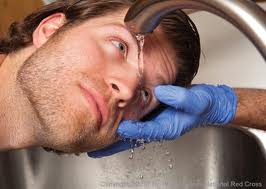 I just received a question from one of our Power Rescue Fans. They asked:
I just received a question from one of our Power Rescue Fans. They asked:
“I just went through a frightening and painful experience at work the other night. I got splashed in my eyes with an acid based cleaner. I know some chemicals that can become more corrosive if water is applied, although that doesn’t go for all of them. What do you do in the case of first aid when you get any type of chemical in your eyes? Is irrigation always the first line treatment? Thanks!”
What a great question. You’re right about the concept that some chemicals could actually cause more damage when water is added. Take the case of phosphorous pentoxide, which can burst into flames upon contact with water, or in the case of other dry alkali chemicals they may actually begin a chemical reaction upon water contact. In most cases “dry” chemicals should be brushed off as best as possible, prior to irrigating with water. When it comes to eyes, the rule of thumb for most chemicals, not the least acid, is flush with sterile or clean water for a minimum of 15 minutes.
Here’s a list of the top five actions to take after you realize there’s an eye emergency:
1. Stay calm and calm the patient with confident words like, I’m Going To Take Good Care of You!
2. Is the scene safe? If not, wait until it is or get personal protective equipment
3. Determine what type of chemical you’re dealing with and read the label for first aid or read the MSDS sheet
4. If the chemical exposure calls for dilution, begin flushing the effected eye(s) with clean or sterile water for at least 15 minutes
5. Tell EMS providers what chemical you’re dealing with, wow much the patient was exposed to, and what treatment has been provided and for how long
The “eye-dia” sorry…is that we manually keep the eyelids open while we flush the eye(s). This should be done in a way that won’t cause cross contamination of the non effected eye. In other words, flush from inside to outside away from the non-affected eye. Activate EMS (911 in the US and 999 in the UK as well as many other countries). The EMS personnel should continue the flushing with sterile water or saline for the duration of the trip to the hospital. Remember, “the solution to pollution is dilution. P.S. Don’t let hysterics get in the way of your treatment. Your patient is going to be scared, blind and really upset. Besides all that…it probably hurts like fire in the eyes, but as rescuers, we have to do what needs to be done and that means holding the eyelids open while flushing.
Keep on Rescuing!

